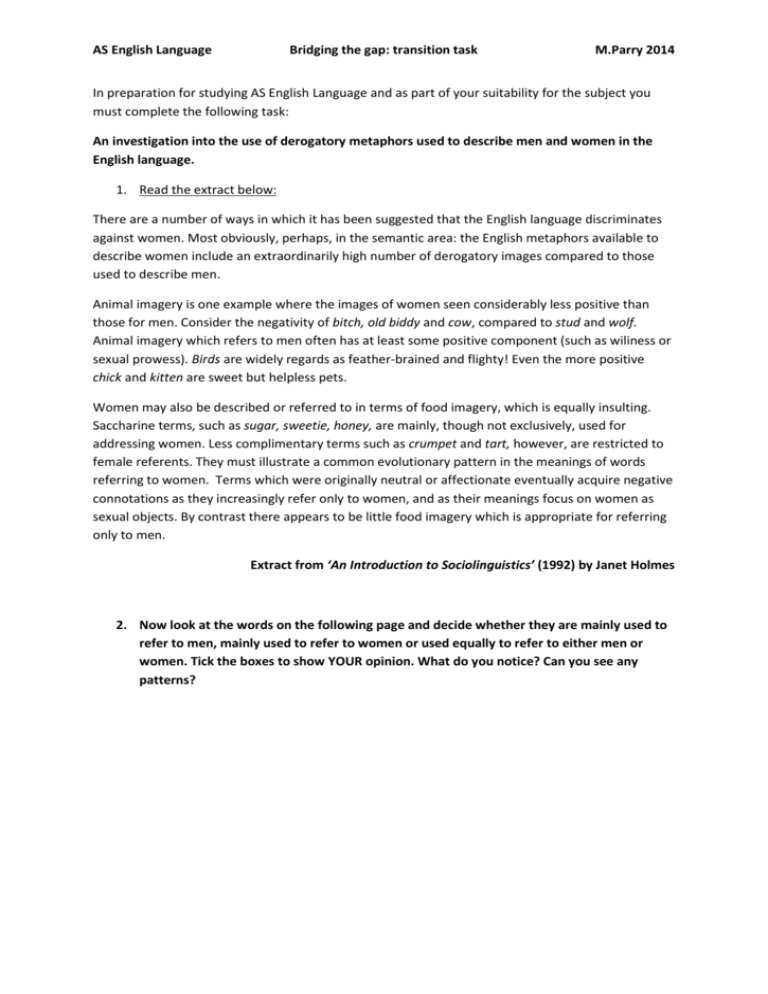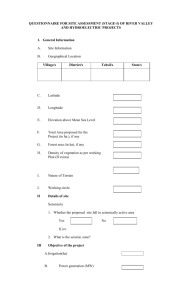
AS English Language
Bridging the gap: transition task
M.Parry 2014
In preparation for studying AS English Language and as part of your suitability for the subject you
must complete the following task:
An investigation into the use of derogatory metaphors used to describe men and women in the
English language.
1. Read the extract below:
There are a number of ways in which it has been suggested that the English language discriminates
against women. Most obviously, perhaps, in the semantic area: the English metaphors available to
describe women include an extraordinarily high number of derogatory images compared to those
used to describe men.
Animal imagery is one example where the images of women seen considerably less positive than
those for men. Consider the negativity of bitch, old biddy and cow, compared to stud and wolf.
Animal imagery which refers to men often has at least some positive component (such as wiliness or
sexual prowess). Birds are widely regards as feather-brained and flighty! Even the more positive
chick and kitten are sweet but helpless pets.
Women may also be described or referred to in terms of food imagery, which is equally insulting.
Saccharine terms, such as sugar, sweetie, honey, are mainly, though not exclusively, used for
addressing women. Less complimentary terms such as crumpet and tart, however, are restricted to
female referents. They must illustrate a common evolutionary pattern in the meanings of words
referring to women. Terms which were originally neutral or affectionate eventually acquire negative
connotations as they increasingly refer only to women, and as their meanings focus on women as
sexual objects. By contrast there appears to be little food imagery which is appropriate for referring
only to men.
Extract from ‘An Introduction to Sociolinguistics’ (1992) by Janet Holmes
2. Now look at the words on the following page and decide whether they are mainly used to
refer to men, mainly used to refer to women or used equally to refer to either men or
women. Tick the boxes to show YOUR opinion. What do you notice? Can you see any
patterns?
AS English Language
WORD
Bridging the gap: transition task
Refers mainly to
males
Refers mainly to
females
Refers equally to
either males or
females
M.Parry 2014
Patterns?
bitch
chick
cow
crumpet
honey
kitten
Old biddy
stud
sugar
sweetie
tart
wolf
3. Now carry out your own investigation into the words used to describe men and women.
Title: ‘Are there more derogatory metaphors available to describe women than men? An
Investigation by...(insert your name)
As part of your investigation you should:
1.
Create a questionnaire asking respondents to record or identify what derogatory terms they
would use to describe/ name a man and those they would use to describe/name a woman.
(You can use the list of words given above and ask people to complete a similar tick chart to the one you
have just completed.)
2.
Decide HOW MANY people you are going to ask to complete the questionnaire? Decide what
age and gender they should be? (Remember you want your sample to be representative of the
population but on a smaller scale.)
3. Consider what other factors might affect your data such as: Cultural background? Where you
might ask them to complete the task: such as in the workplace, at school, or at home?
AS English Language
Bridging the gap: transition task
M.Parry 2014
Whether their responses will be anonymous or not? What other limitations might there be
on your data?
4. When you have compiled your data you should then examine it carefully. You can use tables,
graphs and/or charts to show the results of your findings.
5. Conclusion: Write a brief conclusion (no more than 500words) outlining what conclusions
you can draw from the data that you have collected. You should compare your findings to
the comments made by Janet Holmes in the extract above and explain to what extent your
data supports or disproves her theory.
FINALLY: You should present all your data in a portfolio including the copies of your completed
questionnaires under the title:
‘Are there more derogatory metaphors available to describe women than men? An Investigation
by...(insert your name)
Attached is a proforma that you can use to present your data in
TASK TWO: Once you have completed your investigation you should then write a newspaper article
about how gender bias is reflected in English Language. Your piece should be between 500750words and should be suitable for publication in a broadsheet newspaper such as ‘The Guardian’,
‘The Times’ or ‘The Telegraph’ etc…
Attached is a style model that you can use to help you understand the style and genre of the article,
however this is topic, whilst still about gender, does not directly relate to the research you will have
done into words in the English language that may affect how we view men and women. You will
need to adapt your content appropriately into this style. Copying the content of the style model is
not appropriate and plagiarism will not be tolerated.
Good luck!
AS English Language
Bridging the gap: transition task
M.Parry 2014
‘Are there more derogatory
metaphors available to describe
women than men?’
By (INSERT NAME)
AS English Language
Bridging the gap: transition task
M.Parry 2014
Introduction
Under this section you should explain what your investigation is about
Methodology
Under this section you should explain how you compiled your data – talk about the
questionnaire, who you decided to ask to complete it and WHY.
Analysis
Under this section you should explain what you found out from the data. Look at the
Janet Holmes extract again. Can the words be grouped by animal imagery, by food
etc. Out of all the terms for men and women where there more for one gender than
the other? What did YOUR data show?
Conclusion
Under this section you should explain what you have learnt from your data. Do you
agree or disagree with Janet Holmes (if you have done further research into gender
you could possibly talk about other gender theories here).
Evaluation
Under this section you should explain what you found interesting in this research,
what you found difficult and any problems you had collecting your data. You should
also say how you might expand this research if you had more time.
Appendices
In this section you should put all the copies of your raw data, for example all your
completed questionnaires.









